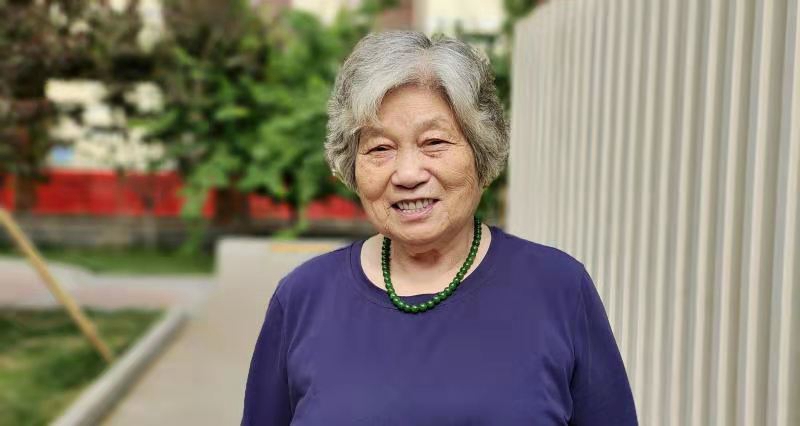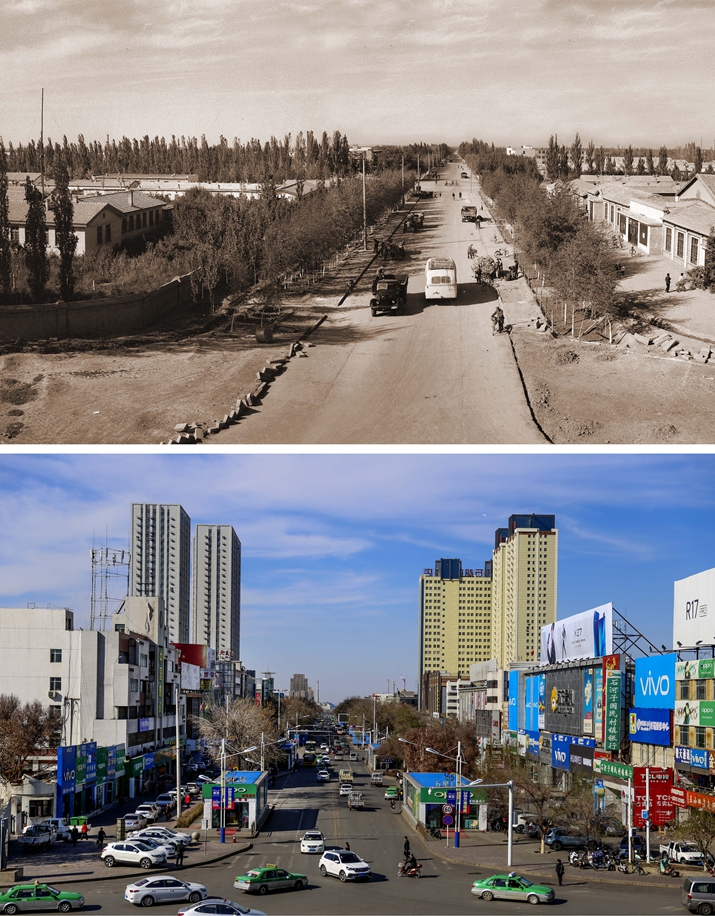At the same time, this was also a good chance for her to step away from a relationship with a young man who she was not fully committed to. "His shanty with thatched roofs did hold me back," Shi said, half jokingly.
However, she didn't expect her boyfriend to find out about her decision and give up his job as a hydraulic engineer in Jiangsu, a province in east China, only to follow her to Xinjiang Uygur Autonomous Region, some 4,000 km away.
Shi's father, secretly hoping that someone could and would take care of his daughter in the totally unknown place, gave a nod to their marriage. Shortly after their wedding, they set off on their journey to Xinjiang in July 1959, when she was 19 and her husband was 24.
Together with another 83 people from the same village, they spent about two weeks on a train traveling to a small town in Changji Hui Autonomous Prefecture, 40 km away from the city of Urumqi, the regional capital.
At that time, Xinjiang locals were mainly Uygurs and Kazaks, as well as Han migrants from neighboring Gansu Province who had been living in Xinjiang for generations.
Recalling her early days in Xinjiang, Shi said, "We worked all day long and built almost everything from scratch." She participated in the construction of canals as well as farming. She got the chance to attend medical training and almost became a teacher before giving birth to her first child in 1962, and then became a house wife.
Although Shi rarely shared these memories with her children, the conversation came into a natural flow when her granddaughter became curious about her own roots.
I am that granddaughter.

Views in Tekes County, in the northern part of Xinjiang Uygur Autonomous Region (XINHUA)
The new frontier
My grandma gets excited whenever she flashes back to her younger years, a time full of youthful vigor, adventurous spirit as well as memories of hard work and struggles.
She was among the first batch of the people moving from Jiangsu to Xinjiang as a campaign to develop the country's border land started in the 1950s, when China was suffering bouts of famine. The country made a decision in 1956 to further reclaim wasteland, when 46,000 people from Henan Province in central China made their way to Xinjiang. Most of China's wasteland lied in border areas, including Xinjiang.
In order to further help Xinjiang catch up with other inland cities, the Central Government decided to encourage more people from densely populated areas to reclaim wasteland there. From 1959 to 1960, over 120,000 young adults moved to Xinjiang from Jiangsu. They were farmers, technicians and teachers, among whom the members of the Communist Party of China (CPC) and the Communist Youth League accounted for 6 percent and 20 percent, respectively.
My grandparents were members of the Communist Youth League, and my grandfather joined the Party the year following their arrival. He poured all his effort into local water projects in Xinjiang. All his life, no matter how hard things got, he never uttered a single complaint. In my memory, he would never miss the prime time news broadcast, the main channel for him to understand the overall development across the country.
In Changji, 40 percent of the reclaimed wasteland was brought under cultivation by those new settlers, who also developed 80 percent of water projects. Around 75 percent of them eventually opted to stay and contribute to the development of the region for a lifetime.

Shi Huifang in 2021 (LI FANGFANG)
Impressions can be deceptive
I lived in Xinjiang up to the age of 17 when I left to pursue my university education in Beijing. I never thought too much about how others see life in Xinjiang.
However, as more and more international attention zoomed in on my hometown, the biases harbored by some people struck me hard. The terms that several Western journalists used to report on Xinjiang, such as "forced labor," tight security checks, and "cultural genocide" sound so foreign to me. Has the Xinjiang where I grew up really changed? With this question in mind, I traveled back to Xinjiang frequently in the past three years, exploring the region from south to north and from countryside to city.
On the whole, the region features more security checks than before; true, and indeed inconvenient. Police check every single passenger's ID. All luggage must go through a scanner… The level of a routine security check in many places is almost as tight as that at the airport. Local people, including myself, have complained about it. But we value safety much more than convenience.
Security levels gradually grew tighter since the terrorist incident on July 5, 2009, when I was a university student in Beijing. The incident caused 197 deaths and injured over 1,700, as well as caused a lot of property damage, according to official data.
From 1990 to the end of 2016, thousands of terrorist attacks in Xinjiang killed a large number of innocent people and hundreds of police officers according to a 2019 white paper entitled The Fight Against Terrorism and Extremism and Human Rights Protection in Xinjiang. Behind the brutal and frightful aggression loomed the radicalized religious penetration launched by separatists.
"Villagers were forbidden to sing and dance during weddings by some radicalized religious people until some five years ago," Mahmut Saidil, a former village head in Aksu Prefecture in south Xinjiang, told me. "Life necessities such as a tea pot, soap or basic communication tools were tagged as non-Halal and villagers were instructed not to use them."
I wish human right fighters could have stood up for those villagers at the time, battling extremists together with all other Chinese people, regardless of ethnicity and religion.
"More Xinjiang voices should be heard. Not just some fabricated fragments," Mahmut added.
For a better life
In Xinjiang, as in other places, people aspire to live a better life. Mehrigul Aysa, a 26-year-old resident of Hotan, a prefecture in Xinjiang, would like an opportunity to work but she has to take care of her children at home. Local governments have introduced more industries into the area so that people can find employment close to home, particularly for women.
Mehrigul found a job at a local textile company in Hotan in 2019. When her husband received further education at a vocational training school, she decided to start learning about selling cosmetics via online classes. She soon was promoted from spinner to warehouse manager after getting on-the-job computer training.
When I met Mehrigul, dressed in a formal outfit, I couldn't tell that she used to be a housewife. "I knew nothing but housework in the past," she said, adding that she'd learned about fashion and parenting methods after work.
"When we visited their houses and talked to them, most women would be shy and not even look us in the eye when talking to us," said Nurgul, a staff member with the women's federation in Hotan Prefecture. She talked about the changes in the women's lives after they started working outside the home.
"But as they now leave their homes to go out to work and interact with more people, they are becoming more outgoing. At their workplaces, they learn about new lifestyles from their colleagues who come from other places."
Previously, when a married woman wanted to buy new clothes, she had to ask her husband to buy them for her. Today, she can pay her own way and can buy them herself, Nurgul continued.
Modern industries
Tursunhan Tursunnyaz, a Hotan farmer, became a full-time employee at a dairy company in 2020. She also acquired several cows from her company using a government subsidy.
The company has offered breeding technology to those villagers raising cows. The local government invested some 75 million yuan ($11 million) to buy cows for 3,766 households in her county living under the national poverty line that year.
"My husband had a donkey cart when I married him 15 years ago," she said. "I support myself now. I can go shopping in the city and enjoy hotpot there," the 35 year-old said. Tursunhan got her driver's license and her family was planning to buy a car.
However, these women wouldn't know they were being regarded as "forced laborers" in the eyes of those with no context of life in Xinjiang.
The textile industry was reported as the main industry to employ "forced labor" to pick cotton or work in the factories. Fact is that the mechanization of cotton-picking started as early as 2001 in Xinjiang, and became universal in 2009.
Fang Xu has worked as a sales support person for cotton-picking machinery for more than 10 years. He is now a sales support manager for the cotton-picking machine division of Urumqi-based China Railway Construction Heavy Industrial Corp. (CRCHI) Xinjiang Co. Ltd.
He serves clients from cooperatives or private rental services across the region. CRCHI's cotton-picking machinery entered the region in 2019. Before that, imported machines dominated the market.
"About 90 percent of the cotton-picking machines were imported before," Fang said. "But domestic brands have boomed in recent years. The market has huge potential and is growing fast."
"Farmers were reluctant to use machines in the beginning," Mahmut elaborated. His hometown of Aksu is the major production base of long-staple cotton. "Cotton-picking machines have been used here for more than a decade and the technology is updating year after year," he said. Meanwhile, drones are being used to spray pesticides across fields.
The main advantage of domestically produced machines, according to Fang, is the 24/7 sales support made possible through the remote monitoring equipment in the machine that can be checked on a mobile phone in real time.
The more information I got from my contacts in Xinjiang, the more respect I wanted to show my grandparents who paved the way for today's Xinjiang. I also realized just how an individual's perspectives can be limited by the lack of first-hand information. I welcome more people to Xinjiang to learn more about this place of beauty and diversity.















